The Carbon Emission Trading Policy of China: Does It Really Boost the Environmental Upgrading?
Abstract
:1. Introduction
1.1. Research Background
1.2. Policy Background
2. Methodology
2.1. Theoretical Framework and Research Hypothesis
2.2. Empirical Framework
2.2.1. Data and Variables
2.2.2. DID Modal
3. Results and Discussion
3.1. Comparative Analysis of Variables’ Means
3.2. Impact of CETP on Carbon Emissions: Mixed OLS and LSDV Estimation
3.3. Robustness Tests
3.3.1. Parallel Trend Analysis
3.3.2. Placebo Test
3.3.3. Granger Causality Test
3.3.4. DID Analysis with a Longer Sample Period
4. Conclusions and Policy Implications
Author Contributions
Funding
Institutional Review Board Statement
Informed Consent Statement
Data Availability Statement
Conflicts of Interest
References
- Wu, R.; Dai, H.; Geng, Y.; Xie, Y.; Masui, T.; Tian, X. Achieving China’s INDC through carbon cap-and-trade: Insights from Shanghai. Appl. Energy 2016, 184, 1114–1122. [Google Scholar] [CrossRef]
- Xu, L.; Fan, M.; Yang, L.; Shao, S. Heterogeneous green innovations and carbon emission performance: Evidence at China’s city level. Energy Econ. 2021, 99, 105269. [Google Scholar] [CrossRef]
- Feng, T.T.; Li, R.; Zhang, H.M.; Gong, X.L.; Yang, Y.S. Induction mechanism and optimization of tradable green certificates and carbon emission trading acting on electricity market in China. Res. Conserv. Recycl. 2021, 169, 105487. [Google Scholar] [CrossRef]
- Jahanger, A. Impact of globalization on CO2 emissions based on EKC hypothesis in developing world: The moderating role of human capital. Environ. Sci. Pollut. Res. 2022, 29, 20731–20751. [Google Scholar] [CrossRef] [PubMed]
- Usman, M.; Jahanger, A.; Makhdum, M.S.A.; Balsalobre-Lorente, D.; Bashir, A. How do financial development, energy consumption, natural resources, and globalization affect Arctic countries’ economic growth and environmental quality? An advanced panel data simulation. Energy 2022, 241, 122515. [Google Scholar] [CrossRef]
- Zhang, Y.; Li, S.; Luo, T.; Gao, J. The effect of emission trading policy on carbon emission reduction: Evidence from an integrated study of pilot regions in China. J. Clean. Prod. 2020, 265, 121843. [Google Scholar] [CrossRef]
- Jia, X.; Zhang, Z.; Wang, F.; Li, Z.; Wang, Y.; Aviso, K.B.; Wang, F. Regional carbon drawdown with enhanced weathering of non-hazardous industrial wastes. Res. Conserv. Recycl. 2022, 176, 105910. [Google Scholar] [CrossRef]
- Mi, Z.; Wei, Y.M.; Wang, B.; Meng, J.; Liu, Z.; Shan, Y.; Guan, D. Socioeconomic impact assessment of China’s CO2 emissions peak prior to 2030. J. Clean. Prod. 2017, 142, 2227–2236. [Google Scholar] [CrossRef] [Green Version]
- Yi, L.; Bai, N.; Yang, L.; Li, Z.; Wang, F. Evaluation on the effectiveness of China’s pilot carbon market policy. J. Clean. Prod. 2020, 246, 119039. [Google Scholar] [CrossRef]
- Wu, L.; Gong, Z. Can national carbon emission trading policy effectively recover GDP losses? A new linear programming-based three-step estimation approach. J. Clean. Prod. 2021, 287, 125052. [Google Scholar] [CrossRef]
- Zhou, Y.; Zhu, S.; He, C. How do environmental regulations affect industrial dynamics? Evidence from China’s pollution-intensive industries. Habitat Int. 2017, 60, 10–18. [Google Scholar] [CrossRef] [Green Version]
- He, C.; Pan, F.; Yan, Y. Is economic transition harmful to China’s urban environment? Evidence from industrial air pollution in Chinese cities. Urban Stud. 2012, 49, 1767–1790. [Google Scholar] [CrossRef]
- Jahanger, A.; Usman, M.; Ahmad, P.A. Step towards sustainable path: The effect of globalization on China’s carbon productivity from panel threshold approach. Environ. Sci. Pollut. Res. 2022, 29, 8353–8368. [Google Scholar] [CrossRef] [PubMed]
- Liu, M.; Li, Y. Environmental Regulation and Green Innovation: Evidence from China’s Carbon Emissions Trading Policy. Financ. Res. Lett. 2022, 48, 103051. [Google Scholar] [CrossRef]
- Hughes, B.B.; Beas-Luna, R.; Barner, A.K.; Brewitt, K.; Brumbaugh, D.R.; Cerny-Chipman, E.B.; Carr, M.H. Long-term studies contribute disproportionately to ecology and policy. BioScience 2017, 67, 271–281. [Google Scholar] [CrossRef] [Green Version]
- Cui, J.; Zhang, J.; Zheng, Y. Carbon pricing induces innovation: Evidence from China’s regional carbon market pilots. AEA Pap. Proceed. 2018, 108, 453–457. [Google Scholar] [CrossRef] [Green Version]
- Huang, W.; Wang, Q.; Li, H.; Fan, H.; Qian, Y.; Klemeš, J.J. Review of recent progress of emission trading policy in China. J. Clean. Prod. 2022, 349, 131480. [Google Scholar] [CrossRef]
- Baker, S.; Eckerberg, K. A policy analysis perspective on ecological restoration. Ecol. Soc. 2013, 18, 17. [Google Scholar] [CrossRef]
- Song, M.; Zhao, X.; Shang, Y. The impact of low-carbon city construction on ecological efficiency: Empirical evidence from quasi-natural experiments. Res. Conser. Recycl. 2020, 157, 104777. [Google Scholar] [CrossRef]
- Yang, X.; Jiang, P.; Pan, Y. Does China’s carbon emission trading policy have an employment double dividend and a Porter effect? Energy Pol. 2020, 142, 111492. [Google Scholar] [CrossRef]
- Xiao, J.; Li, G.; Zhu, B.; Xie, L.; Hu, Y.; Huang, J. Evaluating the impact of carbon emissions trading scheme on Chinese firms’ total factor productivity. J. Clean. Prod. 2021, 306, 127104. [Google Scholar] [CrossRef]
- Lv, M.; Bai, M. Evaluation of China’s carbon emission trading policy from corporate innovation. Financ. Res. Lett. 2021, 39, 101565. [Google Scholar] [CrossRef]
- Liu, Y.; Liu, S.; Shao, X.; He, Y. Policy spillover effect and action mechanism for environmental rights trading on green innovation: Evidence from China’s carbon emissions trading policy. Renew. Sustain. Energy Rev. 2022, 153, 111779. [Google Scholar] [CrossRef]
- Huang, Z.; Du, X. Toward green development? Impact of the carbon emissions trading system on local governments’ land supply in energy-intensive industries in China. Sci. Total Environ. 2020, 738, 139769. [Google Scholar] [CrossRef]
- Chen, X.; Lin, B. Towards carbon neutrality by implementing carbon emissions trading scheme: Policy evaluation in China. Energy Pol. 2021, 157, 112510. [Google Scholar] [CrossRef]
- Jaciow, M.; Rudawska, E.; Sagan, A.; Tkaczyk, J.; Wolny, R. The Influence of Environmental Awareness on Responsible Energy Consumption—The Case of Households. Pol. Energ. 2022, 15, 5339. [Google Scholar] [CrossRef]
- Wan, X.; Jahanger, A.; Usman, M.; Radulescu, M.; Balsalobre-Lorente, D.; Yu, Y. Exploring the effects of economic complexity and the transition to a clean energy pattern on ecological footprint from the Indian perspective. Front. Environ. Sci. 2022, 736, 816519. [Google Scholar] [CrossRef]
- Gao, Y.; Li, M.; Xue, J.; Liu, Y. Evaluation of effectiveness of China’s carbon emissions trading scheme in carbon mitigation. Energy Econ. 2020, 90, 104872. [Google Scholar] [CrossRef]
- De Marchi, V.; Di Maria, E.; Ponte, S. The greening of global value chains: Insights from the furniture industry. Comp. Chang. 2013, 17, 299–318. [Google Scholar] [CrossRef] [Green Version]
- Wang, W.; Xie, P.; Li, C.; Luo, Z.; Zhao, D. The key elements analysis from the mitigation effectiveness assessment of Chinese pilots carbon emission trading system. China Popul. Resour. Environ. 2018, 28, 26–34. [Google Scholar]
- Zhang, Z. Carbon emissions trading in China: The evolution from pilots to a nationwide scheme. Clim. Policy 2015, 15, S104–S126. [Google Scholar] [CrossRef] [Green Version]
- Shahid, R.; Shijie, L.; Yifan, N.; Jian, G. Pathway to Green Growth: A Panel-ARDL Model of Environmental Upgrading, Environmental Regulations, and GVC Participation for Chinese Manufacturing Industry. Front. Environ. Sci. 2022. [Google Scholar] [CrossRef]
- Jahanger, A.; Usman, M.; Balsalobre-Lorente, D. Linking institutional quality to environmental sustainability. Sustain. Dev. 2022, 240, 118245. [Google Scholar] [CrossRef]
- Zheng, J.; Shao, X.; Liu, W.; Kong, J.; Zuo, G. The impact of the pilot program on industrial structure upgrading in low-carbon cities. J. Clean. Prod. 2021, 290, 125868. [Google Scholar] [CrossRef]
- Hu, J.; Pan, X.; Huang, Q. Quantity or quality? The impacts of environmental regulation on firms’ innovation–Quasi-natural experiment based on China’s carbon emissions trading pilot. Technol. Forecast. Soc. Chang. 2020, 158, 120122. [Google Scholar] [CrossRef]
- Thomas, M.D. Growth pole theory, technological change, and regional economic growth. Pap. Reg. Sci. Assoc. 1975, 34, 3–25. [Google Scholar] [CrossRef]
- Grossman, G.M.; Krueger, A.B. Environmental Impacts of a North American Free Trade Agreement; MIT Press: Cambridge, MA, USA, 1991. [Google Scholar] [CrossRef]
- Jahanger, A.; Yu, Y.; Awan, A.; Chishti, M.Z.; Radulescu, M.; Balsalobre-Lorente, D. The Impact of Hydropower Energy in Malaysia Under the EKC Hypothesis: Evidence from Quantile ARDL Approach. SAGE Open 2022, 12, 21582440221109580. [Google Scholar] [CrossRef]
- Jahanger, A. Influence of FDI characteristics on high-quality development of China’s economy. Environ. Sci. Poll. Res. 2021, 28, 18977–18988. [Google Scholar] [CrossRef] [PubMed]
- Yang, B.; Usman, M. Do industrialization, economic growth and globalization processes influence the ecological footprint and healthcare expenditures? Fresh insights based on the STIRPAT model for countries with the highest healthcare expenditures. Sustain. Prod. Consump. 2021, 28, 893–910. [Google Scholar] [CrossRef]
- Wang, D.T.; Chen, W.Y. Foreign direct investment, institutional development, and environmental externalities: Evidence from China. J. Environ. Manag. 2014, 135, 81–90. [Google Scholar] [CrossRef] [Green Version]
- Sharma, S.S. Determinants of carbon dioxide emissions: Empirical evidence from 69 countries. Appl. Energ. 2011, 88, 376–382. [Google Scholar] [CrossRef]
- Dendir, S.; Orlov, A.G.; Roufagalas, J. Do economics courses improve students’ analytical skills? A Difference-in-Difference estimation. J. Econ. Behav. Organ. 2019, 165, 1–20. [Google Scholar] [CrossRef]
- Yang, L.; Li, Y.; Liu, H. Did carbon trade improve green production performance? Evidence from China. Energy Econ. 2021, 96, 105185. [Google Scholar] [CrossRef]
- Wen, F.; Zhao, L.; He, S.; Yang, G. Asymmetric relationship between carbon emission trading market and stock market: Evidences from China. Energy Econ. 2020, 91, 104850. [Google Scholar] [CrossRef]
- Yu, D.J.; Li, J. Evaluating the employment effect of China’s carbon emission trading policy: Based on the perspective of spatial spillover. J. Clean. Prod. 2021, 292, 126052. [Google Scholar] [CrossRef]
- Zhang, Y.J.; Liang, T.; Jin, Y.L.; Shen, B. The impact of carbon trading on economic output and carbon emissions reduction in China’s industrial sectors. Appl. Energy 2020, 260, 114290. [Google Scholar] [CrossRef]
- Cong, R.G.; Wei, Y.M. Potential impact of (CET) carbon emissions trading on China’s power sector: A perspective from different allowance allocation options. Energy 2010, 35, 3921–3931. [Google Scholar] [CrossRef]
- Jahanger, A.; Usman, M.; Murshed, M.; Mahmood, H.; Balsalobre-Lorente, D. The linkages between natural resources, human capital, globalization, economic growth, financial development, and ecological footprint: The moderating role of technological innovations. Res. Pol. 2022, 76, 102569. [Google Scholar] [CrossRef]

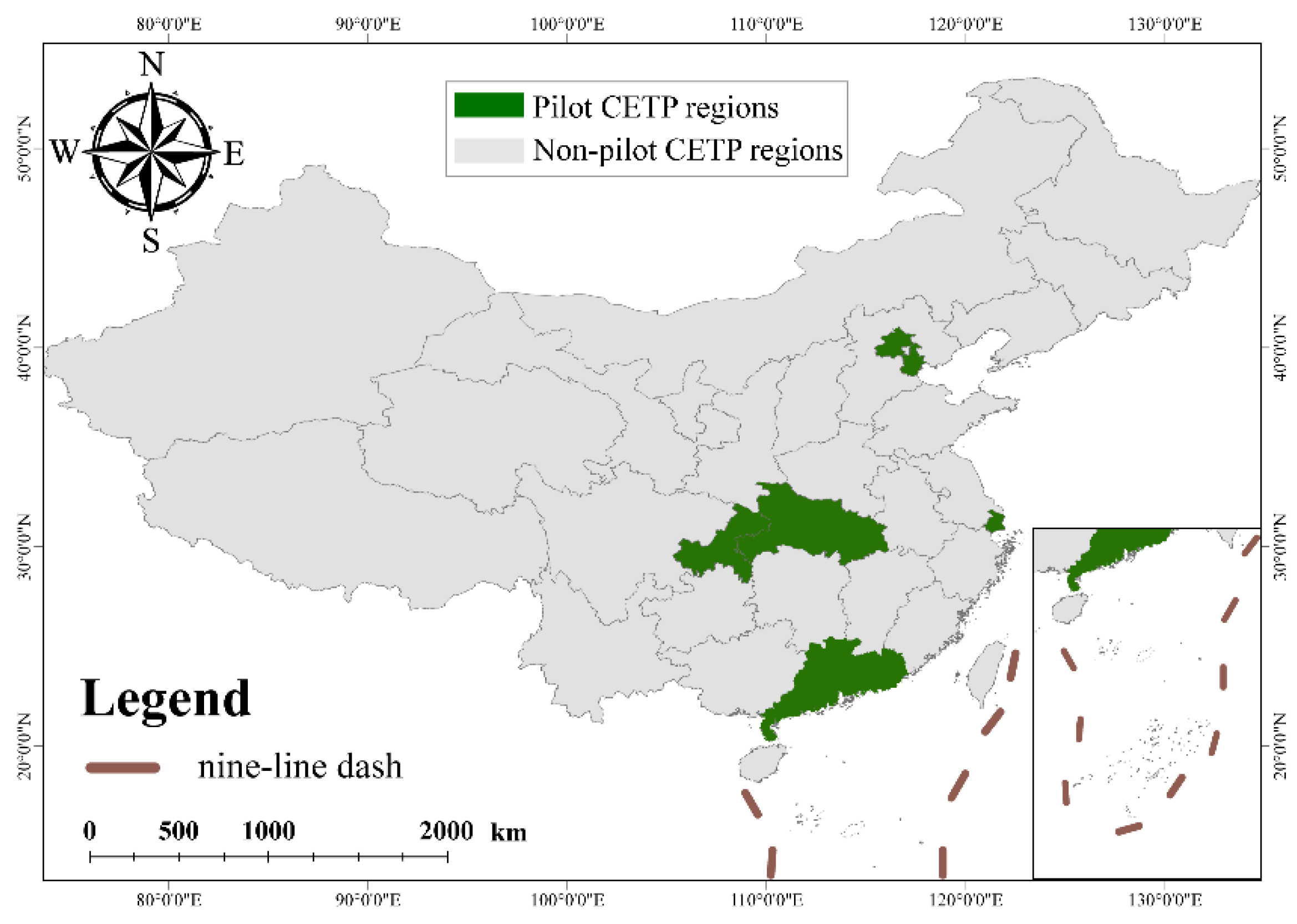
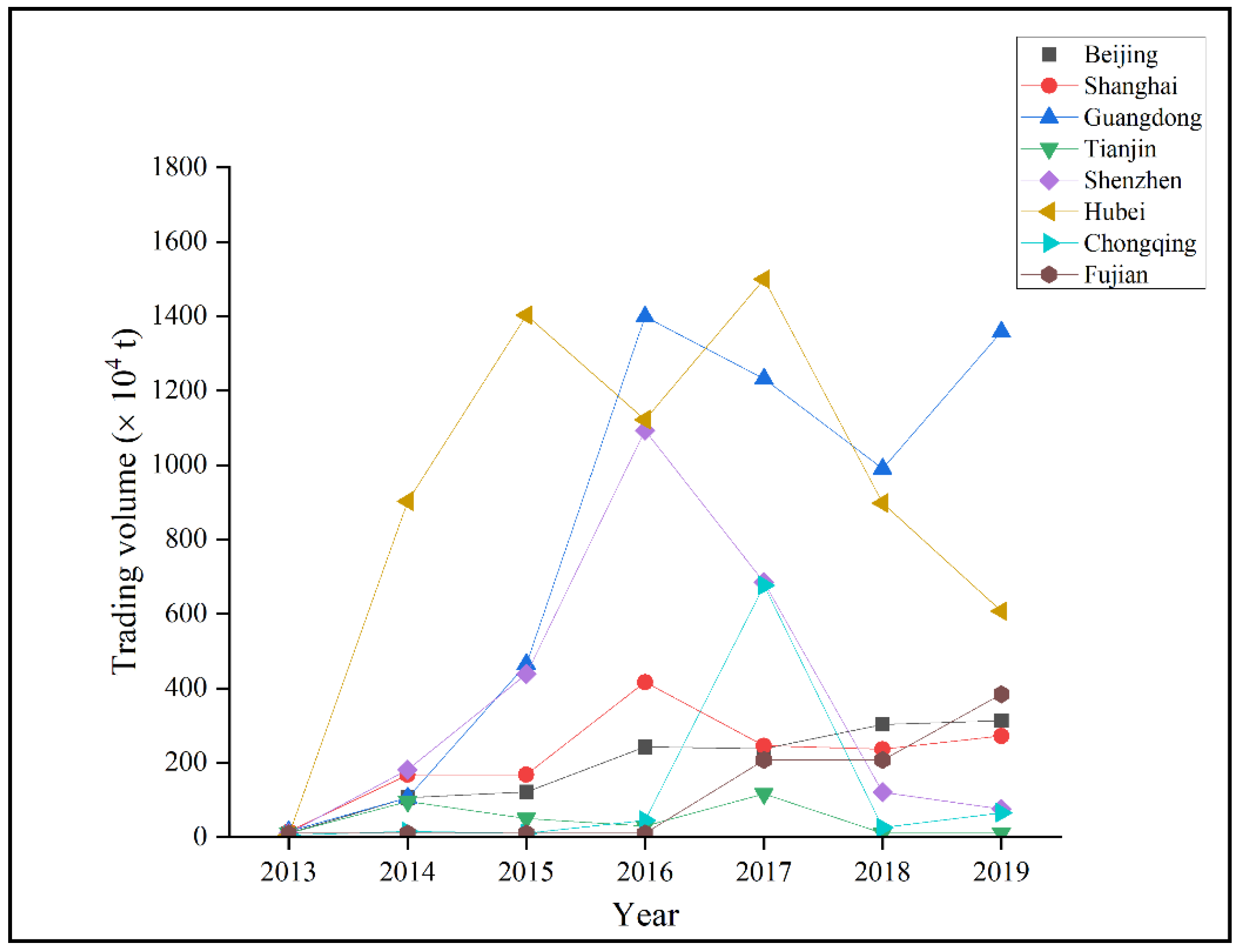
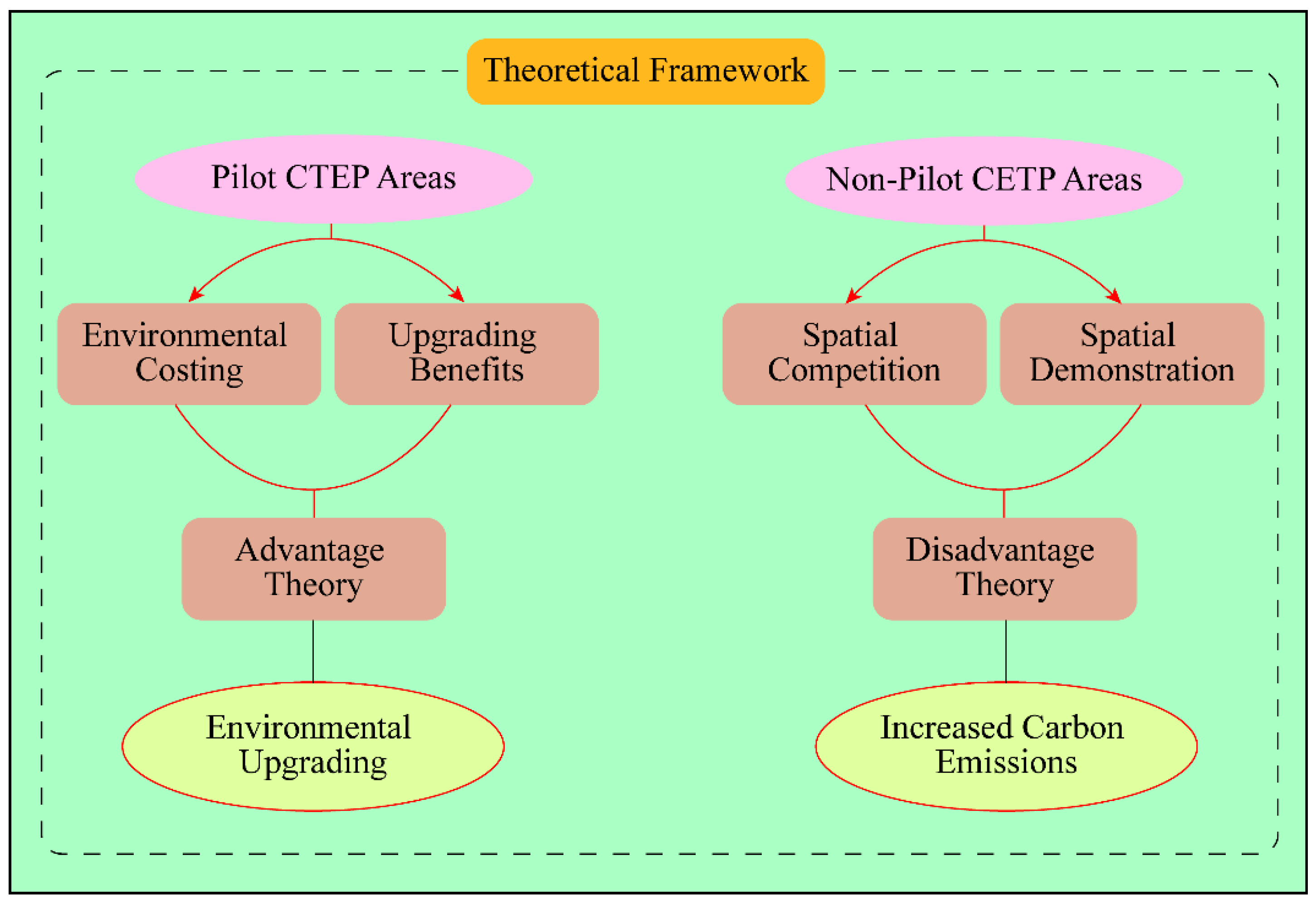
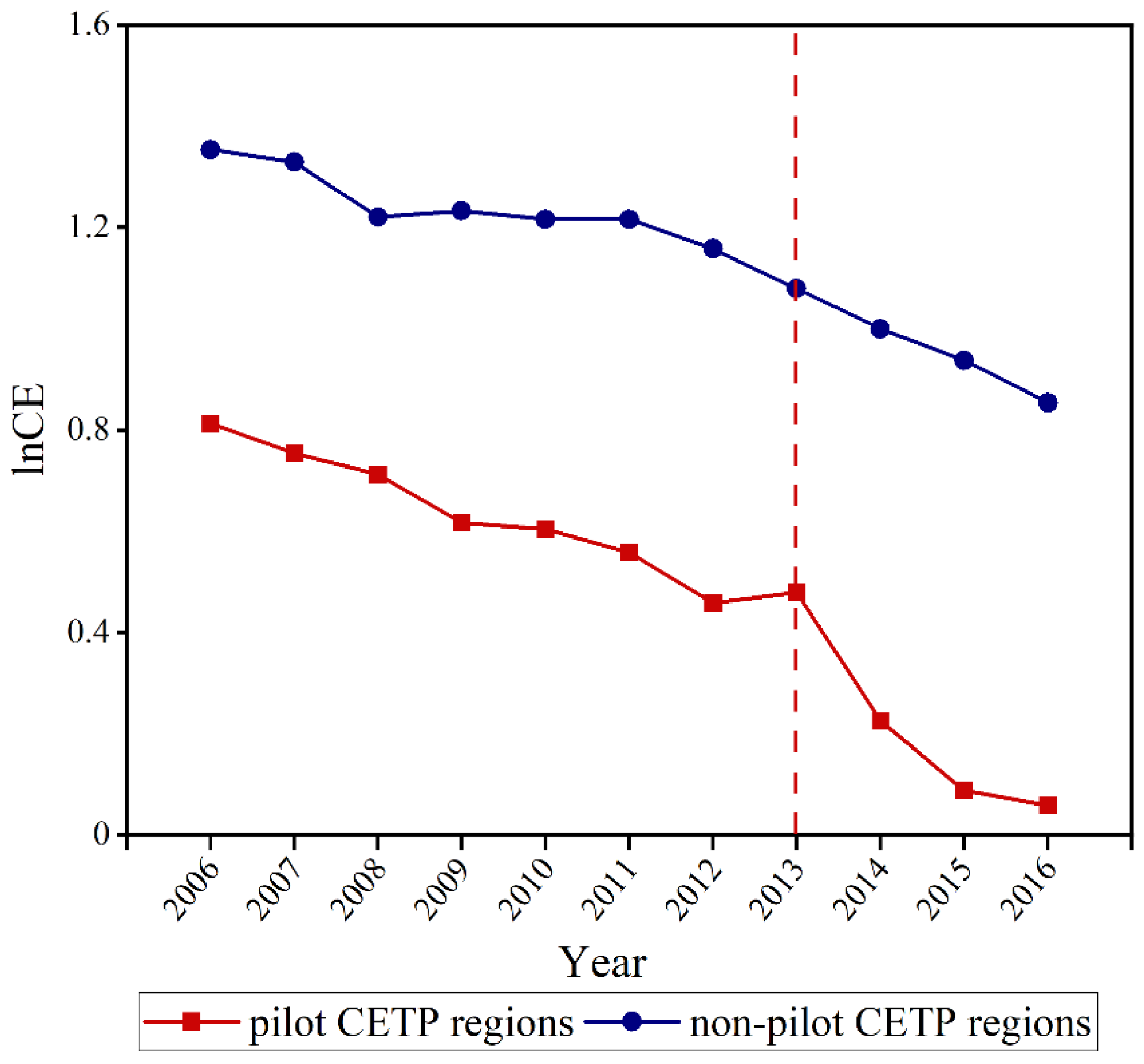
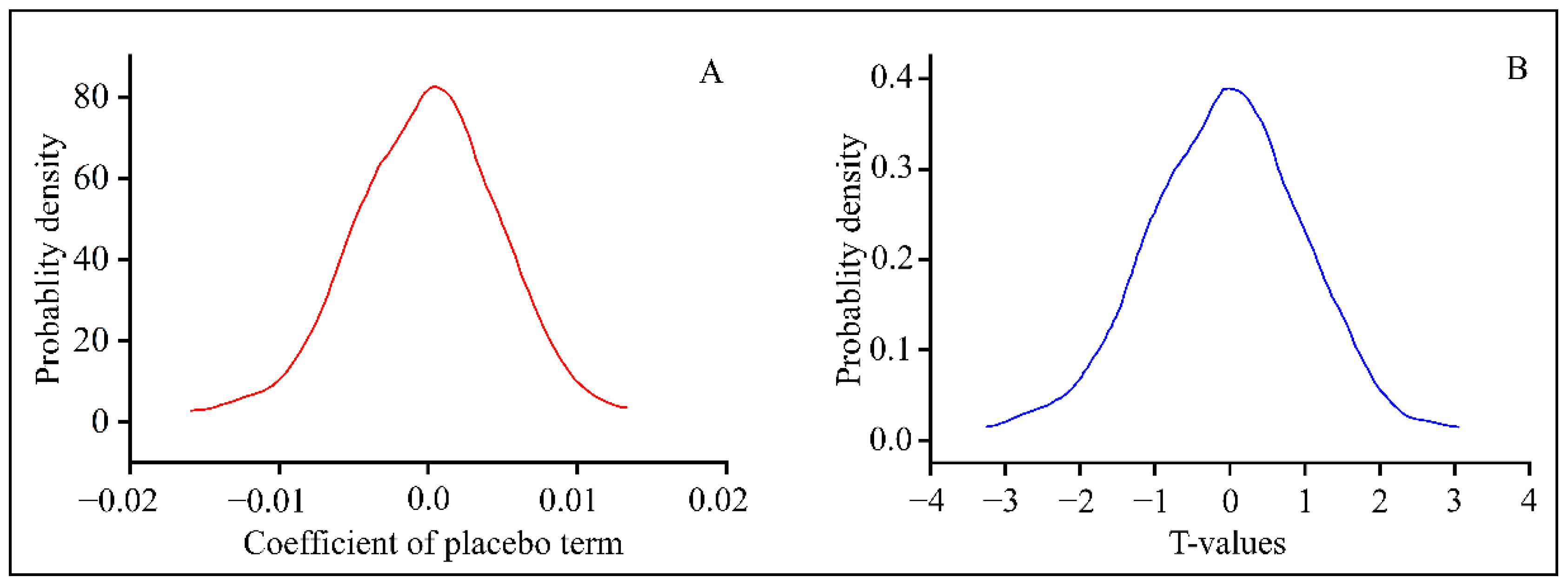
| Variable Name | Description | Descriptive Statistics | |||||||
|---|---|---|---|---|---|---|---|---|---|
| Overall Sample | Pilot CETP Regions | Non-Pilot CETP Regions | |||||||
| Mean | SD | Min | Max | Mean | SD | Mean | SD | ||
| lnCE | Natural log of carbon emissions | 0.55 | 0.53 | 0.21 | 1.25 | 0.51 | 0.46 | 0.62 | 0.55 |
| lnGDP_P | Natural log of per capita GDP | 1.77 | 1.71 | 1.12 | 2.33 | 1.77 | 1.66 | 1.76 | 1.72 |
| lnFDI | Natural log of foreign direct investment | 2.43 | 2.3 | 0.17 | 6.29 | 3.12 | 2.59 | 2.18 | 1.96 |
| lnP | Natural log of population | 3.65 | 3.43 | 2.75 | 4.04 | 3.42 | 3.28 | 3.84 | 3.59 |
| lnIS | Natural log of industrial scale | 0.83 | 0.71 | 0.08 | 1.46 | 0.83 | 0.81 | 0.82 | 0.69 |
| Variable | Mean Value in Pre-Policy Time Period | Mean Value in Post-Policy Time Period | ||
|---|---|---|---|---|
| Experimental Group (Pilot CETP Regions) | Control Group (Non-Pilot CETP Regions) | Experimental Group (Pilot CETP Regions) | Control Group (Non-Pilot CETP Regions) | |
| lnCE | 0.59 | 0.57 | 0.46 | 0.64 |
| lnGDP_P | 1.43 | 1.72 | 1.91 | 1.81 |
| lnFDI | 2.89 | 1.58 | 3.31 | 2.32 |
| lnP | 3.39 | 3.79 | 3.43 | 3.81 |
| lnIS | 0.76 | 0.74 | 0.85 | 0.91 |
| Variable | Pooled OLS Model | LSDV Model | ||
|---|---|---|---|---|
| (1) | (2) | (3) | (4) | |
| post-policy | −0.203 *** (0.031) | −0.211 *** (0.031) | −0.203 *** (0.036) | −0.211 ** (0.052) |
| CETP | −0.163 *** (0.038) | −0.176 *** (0.039) | −0.163 *** (0.041) | −0.176 *** (0.042) |
| CETP × post-policy | −0.121 *** (0.026) | −0.136 *** (0.018) | −0.121 *** (0.034) | −0.136 *** (0.024) |
| Control variables | No | Yes | No | Yes |
| lnGDP_P | - | 0.031 ** (0.072) | - | 0.031 ** (0.061) |
| lnFDI | - | −0.421 ** (0.051) | - | −0.421 ** (0.067) |
| lnP | - | 0.002 (0.137) | - | 0.002 (0.128) |
| lnIS | - | 0.114 ** (0.048) | - | 0.114 ** (0.039) |
| Regional fixed effects | Yes | Yes | Yes | Yes |
| Time fixed effects | Yes | Yes | Yes | Yes |
| Diagnostic Test | Null Hypothesis | F-Stat | Interpretation | Conclusion |
|---|---|---|---|---|
| (1) Granger causality test | 0.39 (0.8721) | No behavior changes prior to treatment | We do not have reasons to distrust the validity of the obtained DID estimates | |
| (2) Parallel trend test | Linear trends are parallel | F = 0.71 (0.2958) | No effect in anticipation of treatment | |
| Variable | Robustness Results with a Longer Sample Period (N = 360) | |
|---|---|---|
| Pooled OLS Model | LSDV Model | |
| post-policy | −0.182 *** (0.029) | −0.182 *** (0.031) |
| CETP | −0.121 *** (0.048) | −0.121 *** (0.036) |
| CETP × post-policy | −0.161 *** (0.0232) | −0.161 *** (0.0392) |
| Control variables | Yes | Yes |
| Regional fixed effects | Yes | Yes |
| Time fixed effects | Yes | Yes |
Publisher’s Note: MDPI stays neutral with regard to jurisdictional claims in published maps and institutional affiliations. |
© 2022 by the authors. Licensee MDPI, Basel, Switzerland. This article is an open access article distributed under the terms and conditions of the Creative Commons Attribution (CC BY) license (https://creativecommons.org/licenses/by/4.0/).
Share and Cite
Shahid, R.; Li, S.; Gao, J.; Altaf, M.A.; Jahanger, A.; Shakoor, A. The Carbon Emission Trading Policy of China: Does It Really Boost the Environmental Upgrading? Energies 2022, 15, 6065. https://doi.org/10.3390/en15166065
Shahid R, Li S, Gao J, Altaf MA, Jahanger A, Shakoor A. The Carbon Emission Trading Policy of China: Does It Really Boost the Environmental Upgrading? Energies. 2022; 15(16):6065. https://doi.org/10.3390/en15166065
Chicago/Turabian StyleShahid, Rabia, Shijie Li, Jian Gao, Muhammad Ahsan Altaf, Atif Jahanger, and Awais Shakoor. 2022. "The Carbon Emission Trading Policy of China: Does It Really Boost the Environmental Upgrading?" Energies 15, no. 16: 6065. https://doi.org/10.3390/en15166065
APA StyleShahid, R., Li, S., Gao, J., Altaf, M. A., Jahanger, A., & Shakoor, A. (2022). The Carbon Emission Trading Policy of China: Does It Really Boost the Environmental Upgrading? Energies, 15(16), 6065. https://doi.org/10.3390/en15166065










